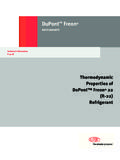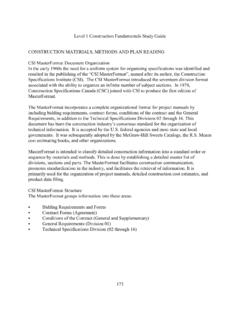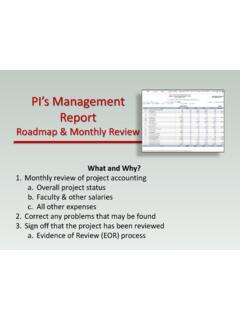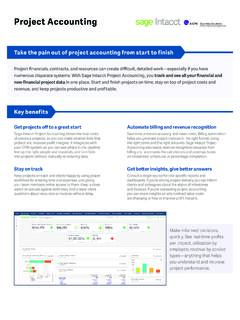Transcription of Budgeting, Costs, and Cost Control
1 Level 1 Construction Fundamentals Study Guide355 budgeting , COSTS, AND cost CONTROLThe Estimate and the project BudgetThe estimate is a static document at a specific point in time (Bid time). The estimate reflectswhat the project was bid for and the quantities and unit prices project budget continuously evolves until project completion. The project budget reflectsthe actual scope at the site and the actual quantities from construction issued drawings and astandard productivity rate. The project budget will always include change orders and extra workorders in terms of changed quantities and costs.
2 These terms are important because theproductivity and labor cost reports should reflect the project budget. Therefore, the projectbudget should reflect the actual quantities placed and a standard unit rate for each work is considered the project budget. The project budget should be compared to the estimate butthis comparison should only be made in the project cost Summary report . This report comparesthe actual and projected quantities, workhours and costs for the project to the estimated costs. This reports the current status and the latest forecast of profit or loss by cost Earned WorkhourAn Earned Workhour is defined as the budgeted workhours earned for the quantity placed usingthe budgeted standard.
3 The earned workhours for a work activity are calculated by multiplyingthe in place quantities (#units) by the budgeted standard workhours per unit rate (whr per unit). Determining the Budgeted QuantitiesThe budgeted quantities should reflect the actual project being built, therefore, these quantitiesshould be calculated by someone in the office capable of determining the quantities for eachwork item from the construction issued drawings. These budgeted quantity takeoffs should betabulated in enough detail for each work item that the field can easily identify the quantity. Thequantity tabulation form should identify the take off by drawing numbers, revision numbers, areanumbers, equipment item numbers, system numbers and elevation.
4 These quantity tabulationsheets are sent to the field and they are used to show work are three basic cost Control Reports. They are the Earned Workhour report , the LaborCost report and the project cost Summary report . The purpose of the reports is to compareactual expenditures to the budgeted costs by the cost code established by the company andorganized into a Work Breakdown Structure. Level 1 Construction Fundamentals Study Guide356 The Earned Workhour ReportThis report is used by the superintendent to track productivity on each work activity. This reportcompares the actual workhour per unit rate to the budgeted workhour per unit rate on a daily orweekly basis for each activity.
5 A budgeted Whr per unit rate is established for each work item( cost code) using the contractor s records for crew sizes and daily outputs. This budgeted Whrper unit rate is standardized throughout the company so that all superintendents are compared tothe same workhour per unit rate for each work item. This budgeted standard unit rate may or maynot be the rate used in the estimate, but for productivity purposes, all superintendents must becompared to the same rate. The budgeted standard unit rate is established by determining a baseyear, the standard crew size and daily output for each activity.
6 The budgeted standard will neverchange, but the standard can be adjusted for each job due to working conditions, location andtrade Earned Workhour report is used to compare the actual workhours expended to the budgetedworkhours and project the final workhours for each activity. The following discussion describeseach column of the Earned Workhour report and the procedure used to arrive at the answer. Code. The cost Code in the Example is Description. The cost code and description are from the contractor s master codeof accounts and all projects within the construction firm are assigned the same cost codewith its respective activity description.
7 The Activity Description in the example is WallForms 12".Level 1 Construction Fundamentals Study quantities are calculated from the plans and they reflect the actual quantitiesthat must be placed. The Budgeted Quantity is found in the Estimate Ledger and it is1120 Square Feet of Contact Area. quantities are the accumulated quantities that have been placed during the week. The Weekly Quantity is found in the Inplace Quantity report and for the example it is 60 Square Feet of Contact Date quantities are an accumulation of all previous weekly quantities. The CurrentWeekly Quantities are added to the To Date Quantity to arrive at the current To Datequantity placed.
8 The To Date Quantity is found in the Inplace Quantity report and for theexample it is 60 for Week + 64 (Previous Weeks) = 124 Square Feet of Contact Unit is the unit of measure used for that cost code. The Unit of measure in the example isSFCA which is an abbreviation for Square Feet of Contact WORKHOURS (Whr)7. Weekly workhours are the accumulated workhours spent for the week. The Weeklyworkhours are found in the Weekly Labor Distribution and in the example it is 9 whrunder the straight time (ST) column which are all hours To Date Workhours isare an accumulation of all previous weekly workhours.
9 The CurrentWeekly Workhours are added to the To Date Workhours to arrive at the current To DateWorkhours expended. The To Date Workhours is The current week of 9 workhours plus the previous workhours from the DetailCost Ledger which is 15 workhours = 24 whr To Date. Level 1 Construction Fundamentals Study Guide358 EARNED WORKHOURS9. Earned Workhours in this column are the total workhours earned to date using thebudgeted workhour unit rate and the quantities placed To Date. The earned workhoursare calculated by multiplying the To Date Quantities times the Budgeted Earned Workhours in the example are earned at the Budgeted unit Rate which is 192 Whr/1120 SF =.
10 171 Whr/SF. Therefore, the total workhours earned is calculated as Placed 124 SFCA x .171 Whr/SFCA = 21 Whr. Workhours are the total workhours estimated to perform this activity. TheBudgeted Workhours are found in the Estimate Ledger and is 192 Unit Workhour Rate is expressed in Whr per unit (Whr/Uint). The budgetedstandard rate is established company wide for each activity. The budgeted unit rate iscalculated by taking the total Budgeted Workhours and dividing by the BudgetedQuantities. The Budgeted Workhours per unit rate in the example is 192 Whr/1120 SFCA = .171 Whr/SFCA Unit Workhour Rate is expressed in Whr per unit (Whr/Uint).













